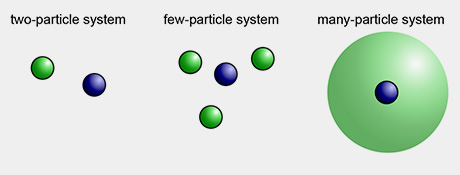But does when a collection of elements forms a "heap" ?
In recent experiments using ultracold atoms, Heidelberg physicists succeeded in observing the transition to a many-body system well described by an infinite number of particles - a problem philosophers call the sorites paradox. The essential question is when a collection of elements forms a "heap".
"Systems comprising many particles are generally extremely difficult to describe in a microscopically exact way. Hence researchers tend to work with effective theories that look not at the individual particles, such as gas molecules in the air, but at macroscopic values such as pressure or temperature," explains senior author Prof. Dr. Selim Jochim of the Max Planck Institute for Nuclear Physics.
They prepared systems so small they could still be described microscopically. Starting with a single atom, the scientists increased the number of particles one by one. The energy of the entire system was measured with each added particle. The experiments ultimately showed that for the system under study very few atoms were needed to apply the theory derived for an infinitely large system.

Formation of a many-body system: A single atom (in blue) serves as a probe to measure the energy of the many-body system as it is formed particle by particle. Credit and link: Heidelberg University
"We can identify this as the direct transition from a few-body system into a many-body system. Simply put, in our system it takes only about four atoms to form a 'heap' in the sense of the sorites paradox," he said.
Two years ago Jochim's team was able to reproducibly control the system used for the current experiments in all of its properties, including the exact number of particles, their state of motion and their interaction.
The overarching question has been asked throughout the ages. Credit: Tootsie Roll.
"To date we are the only research team in the world able to prepare such systems," Prof. Jochim points out. "For the first time, these results realise our vision to gain a much deeper insight into the nature of fundamental few-body systems by these experiments.
Citation: A. N. Wenz, G. Zürn, S. Murmann, I. Brouzos, T. Lompe, S. Jochim: From Few to Many: Observing the Formation of a Fermi Sea One Atom at a Time. Science, Vol. 342 no. 6157 pp. 457-460, 25 October 2013, doi: 10.1126/science.1240516





Comments